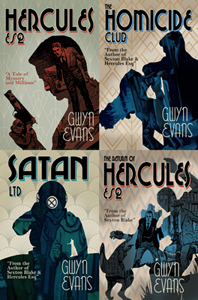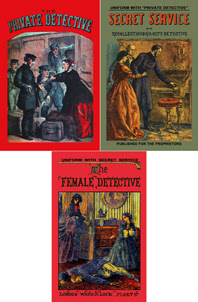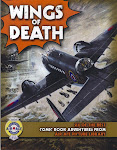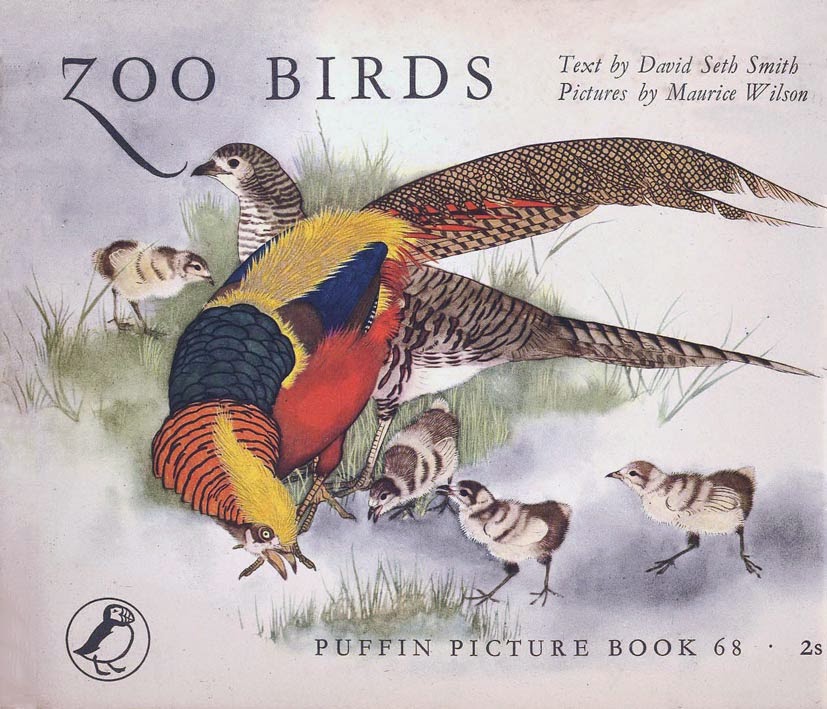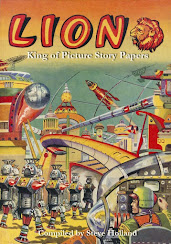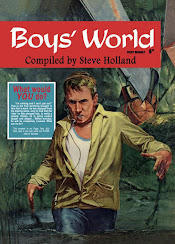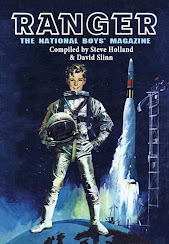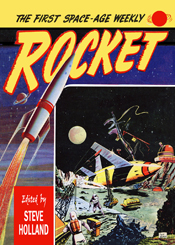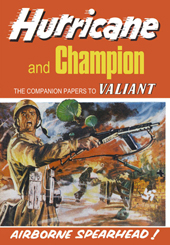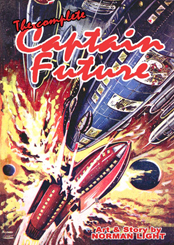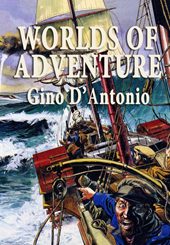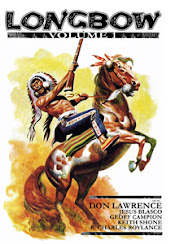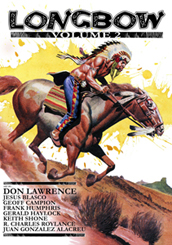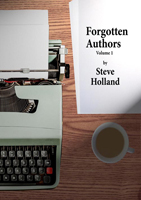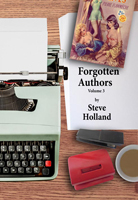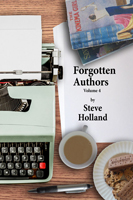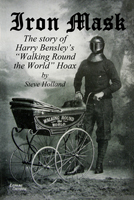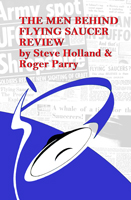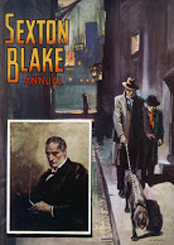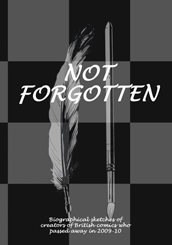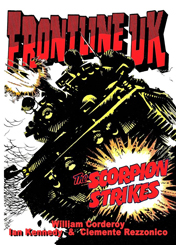Commando issues on sale 31 July 2014
Commando No 4727 – Fisherman’s Foes
Fishing, particularly deep-sea fishing, is one of the most dangerous jobs in the world for the sea is a harsh, cruel and unforgiving place to work. So the idea of strapping guns to a trawler and sending it to war might be expected to start a mutiny amongst any crew.
Not the bunch aboard the Amity, though. They were not only prepared for war, they went looking for it! And that’s when they found themselves facing a legion of… FISHERMEN’S FOES
Story: George Low
Art: Jaume Forns
Cover: Janek Matysiak
Commando No 4728 – Ghost With A Gun
Corporal Benny Walker’s name will never go down in history — but he was the leader of the strangest fighting patrol the British Army had ever known.
It was some patrol, that one!
Benny, six yanks and a couple of ghosts. Yes, the ghosts wore uniforms too — and didn’t they get mucked into the Germans!
Introduction
In the early days, all Commando stories were set in the Second World War. It wasn’t for nearly three decades that they branched out, historically speaking. The only way round this restriction was to introduce substantial flashbacks or to introduce some characters from previous battles. In this case, the introduced characters happen to be ghosts and they just happen to want to use our hero to wipe out the stains of their own misdeeds.
For fear of spoilers I won’t say any more except that you can enjoy Chaco’s cover and Cueto’s inside art, reasonably safe in the knowledge that those are their real names. The name Du Feu has to be a nom-de-plume, though. Surely!—Calum Laird, Commando Editor
Story: Du Feu
Art: Cueto
Cover: Chaco
Originally Commando No 104 (February 1964), re-issued as No 611 (January 1972)
Commando No 4729 – Balkan Battleground
Sergeant Pete Jenkins, a veteran Commando, was posted to Yugoslavia in the autumn of 1944. His mission was to assist and train a Partisan resistance group in their fight against the brutal occupying Nazis and their followers — a militia known as “The Black Wolves”.
But there was a snag, the enemy seemed to know the Partisans’ every move. There had to be a traitor in their midst. Everyone was under suspicion — Pete included.
Story: Ferg Handley
Art: Olivera
Cover: Ian Kennedy
Commando No 4730 – The Little Ships
Think of Britain’s fighting navy in the Second World War and you picture towering battleships, mammoth aircraft carriers, powerful cruisers, sleek destroyers. But alongside them are hosts of smaller craft, without whose efforts the mighty fleets could not operate. They are “the little ships” — trawlers, drifters, coastal craft of all kinds. They served on the seas of the world, and this is the story of just two of them…of the ice-cold courage of their crews.
Introduction
As the title suggests, this memorable maritime tale takes the focus away from sleek Royal Navy vessels and concentrates instead on rather less glamorous vessels. It’s a refreshing change and we get to see an authentically dangerous slice of life in the choppy North Sea. Veteran interior artist Gordon Livingstone delivers the goods as usual but special plaudits go to cover artist Jeff Bevan for his stunning trawler illustration — we can see the rust on the ship’s stern and even below the waterline as the trusty craft surges through the spray of the sea.—Scott Montgomery, Deputy Editor
Story: O’Connell
Art: Gordon Livingstone
Cover: Jeff Bevan
Originally Commando No 940 (June 1975), re-issued as No 2260 (March 1989)
Thursday, July 31, 2014
Maurice Wilson
Born in Hornsey, London, on 15 March 1914, Maurice Charles John Wilson was best
known as a wildlife artist whose work appeared in dozens of books and on
cards given away with Brooke Bond tea. He was educated at the Hastings
School of Art (under Philip Cole) and the Royal Academy Schools (under
Malcolm Osborne and Robert Austin) and later taught anatomical and plant
drawing.
As early as 1941, Wilson was described as having "driven a car through various parts of the continent ... he can ride a horse, keeps a bob-tailed collie, favours Chinese, Japanese, Indian and Mogul painting and lives any odd way that suits him at the moment."
Wilson's first nature book, a study of monkeys, was published in 1937 and was followed with studies of dogs and a variety of zoo animals, published after the Second World War. His water colour paintings attracted the attention of the British Museum and Natural History Museum, where he helped reconstruct the look of dinosaurs from fossils. His work in this area was much respected and the Natural History Museum website notes:
One, a picture of a Neanderthal family painted in 1950, featured Giles Oakley and his brother as models for two young Neanderthals having a childish scrap. He later recalled:
Illustrated Books
Just Monkeys. London, Country Life, 1937.
Dogs. Harmondsworth, Penguin Books (Puffin Picture Book 56), 1946.
Coastal Craft. London, Noel Carrington, 1947.
Animals We Know. London, Thomas Nelson & Sons, 1959.
Animals. London, Studio Vista, 1964.
Birds. London, Studio Vista, 1965.
Books Illustrated
Zoo Animals by E. G. Boulenger. West Drayton, Penguin Books (Puffin Picture Books 73), 1948.
History of the Primates: An Introduction to the Study of Fossil Man by Wilfred Le Gros Clark. London, British Museum, 1949.
Zoo Birds by David Seth Smith. Harmondsworth, Penguin Books (Puffin Picture Books 68), 1951.
Fossil Amphibians and Reptiles by W. E. Swinton. London, British Museum, 1954.
A Guide to Earth History by Richard Carrington. London, Chatto & Windus, 1956.
Birds and Beasts ed. James Fisher. London, Phoenix House, 1956.
Mermaids and Mastadons: A Book of Unnatural History by Richard Carrington. London, Chatto & Windus, 1957.
Elephants by Richard Carrington, illus. with others. London, Chatto & Windus, 1958.
Fossil Birds by W. E. Swinton. London, British Museum, 1958.
Fossils by H. H. Swinnerton. London, Collins, 1960.
The Singing Forest by H. Mortimer Batten. London, Heinmann, 1960.
Under the Sea by Maurice Burton. London, Vista Books, 1960.
Fables from Aesop retold by James Reeves. London & Glasgow, Blackie, 1961.
The Heart of the Hunter by Laurens van der Post. London, Hogarth Press, 1961.
Donkey Work by Doreen Tovey. London, Elek Books, 1962.
A World of Animals by Margery Fisher. Leicester, Brockhampton Press, 1962.
Animals of the Arctic by Gwynne Vevers. London, Bodley Head, 1964.
Nature on the Move by Ronald Marchant. London, Bell, 1965.
Bambi: A Life in the Woods by Felix Salten. London, Hodder & Stoughton, 1967.
A River Ran Out of Eden by James Vance Marshall. London, Heinemann Educational Books, 1967.
The Origins of Man by John Russell Napier. London, Bodley Head, 1968.
First Interest on the Farm by Peter Shaw. London, Ginn, 7 vols., 1969.
A Long Time Ago by Robin Place, London, Ginn, 14 vols., 1969-70.
The New Boy by Doreen Tovey. London, Joseph, 1970.
Patch by Helen Griffiths. London, Hutchinson, 1970.
Man, Civilzation and Conquest by Margaret Sharman. London, Evans Bros, 1971.
China Long Ago by Sandie Oram. London, Macdonald & Co., 1972.
First Interest in the Wider World by E. J. Barker. London, Ginn, 7 vols., 1972.
Double Trouble by Doreen Tovey. London, Joseph, 1972; New York, Norton, 1972.
Making the Horse Laugh by Doreen Tovey. London, Joseph, 1974.
The Earliest Farmers and the First Cities by Charles Higham, illus. with Peter Duncan. London, Cambridge University Press, 1974.
The Quizzer Book About People compiled by George Beal, illus. with Jon Davis. London, Owlet Books, 1975.
Oh Those Cats by Frances Mann. London, Elek Books, 1975.
A Quorum of Cats: An Anthology ed. Elizabeth Lee. London, Elek Books, 1976.
A Closer Look at Arctic Lands by Jill Hughes. London, Hamilton, 1976.
Prehistoric Animals by Barry Cox. Guildford, Lutterworth Press, 1976.
A Closer Look at Plains Indians by Christopher Davis, illus. with George Thompson. London, Hamilton, 1977.
A Closer Look at Eskimos by Jill Hughes. London, Hamilton, 1977.
Ponies by Joyce Pope. London, Scimitar, 1977.
Birds of Prey by Cathy Kilpatrick. illus. with Mike Woodhatch. London, Scimitar, 1978.
A Closer Look at Amazonian Indians by Stephen Hugh-Jones. London, Hamilton, 1978.
A Closer Look at the Bedouin by Fidelity Lancaster. London, Hamilton, 1978.
Cats in the Belfry by Doreen Tovey. Stevenage, Herts., Robin Clark, 1978.
Horses ed. Henry Pluckrose, illus. with Peter Barrett. London, Hamilton, 1979.
Lions and Tigers ed. Henry Pluckrose. London, Hamilton, 1979.
A Closer Look at Aboriginies by Jill Hughes, London, Hamilton, 1979.
Birds ed. Henry Pluckrose, illus. with John RIgnall. London, Hamilton, 1979.
A Comfort of Cats by Doreen Tovey. London, Joseph, 1979.
A Closer Look at Grasslands by Catherine Horton. London, Hamilton, 1979.
Lifeclass by Jean Medawar. London, Hamilton, 1980.
Plains Indians ed. Henry Pluckrose. London, Hamilton, 1980.
Aborigines ed. Henry Pluckrose. London, Hamilton, 1981.
The Jungle Book by Rudyard Kipling. London, Macmillan Children's, 1983.
The Second Jungle Book by Rudyard Kipling. London, Macmillan Children's, 1984.
All the Mowgli Stories by Rudyard Kipling. London, Macmillan, 1984.
Lions and Tigers by Jill Hughes, illus. with Peter Barrett. London, Hamilton, 1985.
Deserts by Jill Hughes, illus. with Roy Coombs. London, Hamilton, 1986.
Human Evolution: An Illustrated Guide by Peter Andrews and Chris Stringer, foreword by Alan Charig. London, British Museum, 1989.
Others
How Things Began (8 educational posters). London, BBC Educational, 1950.
Prehistoric Animals. Brooke Bond, 1971.
Wonders of Wildlife. Brooke Bond, 1976.
(* Note: The original text for this piece included the following, which has since been proven to relate to another Maurice Wilson entirely:
As early as 1941, Wilson was described as having "driven a car through various parts of the continent ... he can ride a horse, keeps a bob-tailed collie, favours Chinese, Japanese, Indian and Mogul painting and lives any odd way that suits him at the moment."
Wilson's first nature book, a study of monkeys, was published in 1937 and was followed with studies of dogs and a variety of zoo animals, published after the Second World War. His water colour paintings attracted the attention of the British Museum and Natural History Museum, where he helped reconstruct the look of dinosaurs from fossils. His work in this area was much respected and the Natural History Museum website notes:
Wilson's style was very versatile, but he is best known for his prehistoric reconstructions. His talent for representing prehistoric life lay in his ability to bring to life creatures never seen by humans by giving a sheen to feathers, or by using a light and dark contrast to hairs of mammals. By painting scenery in a realistic way, he also gave his subjects a definite scale and placed prehistoric animals in an historical context.The later Prehistoric Animals by Barry Cox (1976) was produced in association with the Thames Television series and Wilson was also a graphic designer on the TV documentary Life on Earth (1979).
His anthropological work can be found in Peter Andrews and Chris Stringer's publication Human Evolution: An Illustrated Guide (1989), with his animal reconstructions published in W. E. Swinton's very popular handbooks which included Fossil Amphibian and Reptiles (1954) and Fossil Birds (1958). Wilson also illustrated Wilfrid Le Gros Clark's, A History of the Primates (1949) with a series of fine black and white drawings whilst other illustrations have accompanied displays in the Museum's public galleries.
One, a picture of a Neanderthal family painted in 1950, featured Giles Oakley and his brother as models for two young Neanderthals having a childish scrap. He later recalled:
Maurice was a real character, as I recall from his regular and keenly-awaited visits to our home in Amersham, Bucks, some thirty-odd miles from London. An eccentric, bohemian dresser, he'd bound out of the car and stride up the front path clad in a long coat with string round the waist plus open-toed sandals and a raffish cravat at his neck. His hair was worn fairly long in oiled ringlets like a stereotypical gypsy, making him for years my image of what 'an artist' was like, not unlike some Agatha Christie suspect. He had a beguiling approach with children, never talking down to us but full of little tricks and jokes to keep us entertained, although it was always clear that he was deeply serious about his work as a natural history illustrator.
My parents greatly admired his artistic skill which was characterised by a deceptively simple mastery of line and shading, enriched by subtle colour washes and an overall softness of tone. Several of his paintings and prints used to adorn the walls at home in Amersham and they are still much loved in the family. One of those I inherited used to hang above my father's desk in his study, a large sketch Maurice did in April 1950 of 'Australopithecos', looking faintly melancholy and soulful, as though dimly conscious of his evolutionary fate. Whether conjuring up an imagined past in deep antiquity or simply painting feathers and fur from direct observation, there was always a warmth and humanity about Maurice's work, often caught in the poignant expressiveness of a creature's eyes.
Wilson lived in Tunbridge Wells, Kent, where he died in November 1987.
Illustrated Books
Just Monkeys. London, Country Life, 1937.
Dogs. Harmondsworth, Penguin Books (Puffin Picture Book 56), 1946.
Coastal Craft. London, Noel Carrington, 1947.
Animals We Know. London, Thomas Nelson & Sons, 1959.
Animals. London, Studio Vista, 1964.
Birds. London, Studio Vista, 1965.
Books Illustrated
Zoo Animals by E. G. Boulenger. West Drayton, Penguin Books (Puffin Picture Books 73), 1948.
History of the Primates: An Introduction to the Study of Fossil Man by Wilfred Le Gros Clark. London, British Museum, 1949.
Zoo Birds by David Seth Smith. Harmondsworth, Penguin Books (Puffin Picture Books 68), 1951.
Fossil Amphibians and Reptiles by W. E. Swinton. London, British Museum, 1954.
A Guide to Earth History by Richard Carrington. London, Chatto & Windus, 1956.
Birds and Beasts ed. James Fisher. London, Phoenix House, 1956.
Mermaids and Mastadons: A Book of Unnatural History by Richard Carrington. London, Chatto & Windus, 1957.
Elephants by Richard Carrington, illus. with others. London, Chatto & Windus, 1958.
Fossil Birds by W. E. Swinton. London, British Museum, 1958.
Fossils by H. H. Swinnerton. London, Collins, 1960.
The Singing Forest by H. Mortimer Batten. London, Heinmann, 1960.
Under the Sea by Maurice Burton. London, Vista Books, 1960.
Fables from Aesop retold by James Reeves. London & Glasgow, Blackie, 1961.
The Heart of the Hunter by Laurens van der Post. London, Hogarth Press, 1961.
Donkey Work by Doreen Tovey. London, Elek Books, 1962.
A World of Animals by Margery Fisher. Leicester, Brockhampton Press, 1962.
Animals of the Arctic by Gwynne Vevers. London, Bodley Head, 1964.
Nature on the Move by Ronald Marchant. London, Bell, 1965.
Bambi: A Life in the Woods by Felix Salten. London, Hodder & Stoughton, 1967.
A River Ran Out of Eden by James Vance Marshall. London, Heinemann Educational Books, 1967.
The Origins of Man by John Russell Napier. London, Bodley Head, 1968.
First Interest on the Farm by Peter Shaw. London, Ginn, 7 vols., 1969.
A Long Time Ago by Robin Place, London, Ginn, 14 vols., 1969-70.
The New Boy by Doreen Tovey. London, Joseph, 1970.
Patch by Helen Griffiths. London, Hutchinson, 1970.
Man, Civilzation and Conquest by Margaret Sharman. London, Evans Bros, 1971.
China Long Ago by Sandie Oram. London, Macdonald & Co., 1972.
First Interest in the Wider World by E. J. Barker. London, Ginn, 7 vols., 1972.
Double Trouble by Doreen Tovey. London, Joseph, 1972; New York, Norton, 1972.
Making the Horse Laugh by Doreen Tovey. London, Joseph, 1974.
The Earliest Farmers and the First Cities by Charles Higham, illus. with Peter Duncan. London, Cambridge University Press, 1974.
The Quizzer Book About People compiled by George Beal, illus. with Jon Davis. London, Owlet Books, 1975.
Oh Those Cats by Frances Mann. London, Elek Books, 1975.
A Quorum of Cats: An Anthology ed. Elizabeth Lee. London, Elek Books, 1976.
A Closer Look at Arctic Lands by Jill Hughes. London, Hamilton, 1976.
Prehistoric Animals by Barry Cox. Guildford, Lutterworth Press, 1976.
A Closer Look at Plains Indians by Christopher Davis, illus. with George Thompson. London, Hamilton, 1977.
A Closer Look at Eskimos by Jill Hughes. London, Hamilton, 1977.
Ponies by Joyce Pope. London, Scimitar, 1977.
Birds of Prey by Cathy Kilpatrick. illus. with Mike Woodhatch. London, Scimitar, 1978.
A Closer Look at Amazonian Indians by Stephen Hugh-Jones. London, Hamilton, 1978.
A Closer Look at the Bedouin by Fidelity Lancaster. London, Hamilton, 1978.
Cats in the Belfry by Doreen Tovey. Stevenage, Herts., Robin Clark, 1978.
Horses ed. Henry Pluckrose, illus. with Peter Barrett. London, Hamilton, 1979.
Lions and Tigers ed. Henry Pluckrose. London, Hamilton, 1979.
A Closer Look at Aboriginies by Jill Hughes, London, Hamilton, 1979.
Birds ed. Henry Pluckrose, illus. with John RIgnall. London, Hamilton, 1979.
A Comfort of Cats by Doreen Tovey. London, Joseph, 1979.
A Closer Look at Grasslands by Catherine Horton. London, Hamilton, 1979.
Lifeclass by Jean Medawar. London, Hamilton, 1980.
Plains Indians ed. Henry Pluckrose. London, Hamilton, 1980.
Aborigines ed. Henry Pluckrose. London, Hamilton, 1981.
The Jungle Book by Rudyard Kipling. London, Macmillan Children's, 1983.
The Second Jungle Book by Rudyard Kipling. London, Macmillan Children's, 1984.
All the Mowgli Stories by Rudyard Kipling. London, Macmillan, 1984.
Lions and Tigers by Jill Hughes, illus. with Peter Barrett. London, Hamilton, 1985.
Deserts by Jill Hughes, illus. with Roy Coombs. London, Hamilton, 1986.
Human Evolution: An Illustrated Guide by Peter Andrews and Chris Stringer, foreword by Alan Charig. London, British Museum, 1989.
Others
How Things Began (8 educational posters). London, BBC Educational, 1950.
Prehistoric Animals. Brooke Bond, 1971.
Wonders of Wildlife. Brooke Bond, 1976.
(* Note: The original text for this piece included the following, which has since been proven to relate to another Maurice Wilson entirely:
Wilson's autobiography, The Wartime Adventures of B Squadron 'Corpse' (Tunbridge Wells, Parapress, 1997), was publishing posthumously, relating how he joined the 11th
Battalion Royal Tank Regiment in 1941 and spent much of the war in a
Matilda tank, weathering sandstorms in the Middle East, taking part in
the landings at Walcheren and in the 'CDL' experiment which involved
placing blindingly bright carbon arc lamps in the turrets of tanks to
create a wall of light when the tanks were lined up—an idea that was
never used in battle)
Labels:
Artist
Wednesday, July 30, 2014
Tuesday, July 29, 2014
C J Ashford
At the age of 94, C. J. Ashford has had an astonishingly long career which continues to expand as more paintings emerge from his studio, a converted garage at his home of over 60 years at Shooters Hill. He is famous for his aircraft paintings, but is also a specialist maritime artist who has also painted steam trains and cars. His artwork is meticulously researched and convincingly painted in watercolours and occasionally in oils. He has also produced covers for books and magazines, postcards, posters and illustrations for the First World War Aviation Historical Society's Cross and Cockade and books published for the RAF Benevolent Fund, including Wright to Fly.
Colin James Ashford was born in Ackworth, Yorkshire, in March 1919 and is still painting. He attended Ackworth Quaker School, where his teachers told his parents that they could teach the naturally talented youngster nothing further about drawing. He won a Junior Exhibition to study art for four years (1933-37) at Wakefield School of Art, followed by three years (1937-39) at Glasgow School of Art, where he won drawing and painting prizes.
He was interested in both aviation—having first flown in a bi-plane piloted by a Great War veteran whilst still at school—and maritime art. He would spend his holidays on fishing boats out of Scarborough trawling for herring.
He joined the First Battalion Scottish Light Infantry during the Second World War and arrived in France as part of the British Expeditionary Force shortly before the Dunkirk evacuation. Sent to defend the gap in the Allied front created by Belgium's surrender, the Infantry dug in over night after a rapid march and held out for 24 hours against a superior force, which included two Panzer divisions. Ashford, wounded in the leg, was taken to Poperinge, Belgium, and found taken back into battle as part of an artillery unit after accepting a ride with a tracked bren-gun carrier. Soon after, he found himself shoulder-deep in water whilst trying to cross a river where the bridge had been demolished. He spent two days on the beach at Dunkirk before being returned home.
After three months hospitalisation recovering from his wound and shell-shock, he served with the Royal Engineers in North Africa and Italy. His artistic talents were employed in developing camouflage.
After the war he took a job with a publisher, working freelance in his spare time. In 1959, he was commissioned to illustrate an aerial photographic sortie by an Airco DH.9 flying over Crystal Palace. The resulting artwork attracted the attention of Freeman, Fox and Partners, a firm of consulting engineers, who hired him to produce artwork for numerous bridge and road building projects.
His paintings can be found in the Royal Air Force Museum, the Yorkshire Air Museum, Hendon RAF Museum, the National Maritime Museum, Omaka Aviation Heritage Centre in New Zealand and other museums around the world.
He continues to be exhibited at the Aviation Paintings of the Year exhibition at the Mall Galleries. The latter exhibition is organised by the Guild of Aviation Artists, which Ashford was a founder member of. Created in 1971 to promote aviation art, the Guild now has over 500 members worldwide. Ashford has won the Guild's Hawker Siddeley Trophy for best watercolour of the year more than once and was elected Vice President in 2010.
(* Much of the above information is derived from an interview with Ashford at the e-Shooters Hill website.)
Colin James Ashford was born in Ackworth, Yorkshire, in March 1919 and is still painting. He attended Ackworth Quaker School, where his teachers told his parents that they could teach the naturally talented youngster nothing further about drawing. He won a Junior Exhibition to study art for four years (1933-37) at Wakefield School of Art, followed by three years (1937-39) at Glasgow School of Art, where he won drawing and painting prizes.
He was interested in both aviation—having first flown in a bi-plane piloted by a Great War veteran whilst still at school—and maritime art. He would spend his holidays on fishing boats out of Scarborough trawling for herring.
He joined the First Battalion Scottish Light Infantry during the Second World War and arrived in France as part of the British Expeditionary Force shortly before the Dunkirk evacuation. Sent to defend the gap in the Allied front created by Belgium's surrender, the Infantry dug in over night after a rapid march and held out for 24 hours against a superior force, which included two Panzer divisions. Ashford, wounded in the leg, was taken to Poperinge, Belgium, and found taken back into battle as part of an artillery unit after accepting a ride with a tracked bren-gun carrier. Soon after, he found himself shoulder-deep in water whilst trying to cross a river where the bridge had been demolished. He spent two days on the beach at Dunkirk before being returned home.
After three months hospitalisation recovering from his wound and shell-shock, he served with the Royal Engineers in North Africa and Italy. His artistic talents were employed in developing camouflage.
After the war he took a job with a publisher, working freelance in his spare time. In 1959, he was commissioned to illustrate an aerial photographic sortie by an Airco DH.9 flying over Crystal Palace. The resulting artwork attracted the attention of Freeman, Fox and Partners, a firm of consulting engineers, who hired him to produce artwork for numerous bridge and road building projects.
His paintings can be found in the Royal Air Force Museum, the Yorkshire Air Museum, Hendon RAF Museum, the National Maritime Museum, Omaka Aviation Heritage Centre in New Zealand and other museums around the world.
He continues to be exhibited at the Aviation Paintings of the Year exhibition at the Mall Galleries. The latter exhibition is organised by the Guild of Aviation Artists, which Ashford was a founder member of. Created in 1971 to promote aviation art, the Guild now has over 500 members worldwide. Ashford has won the Guild's Hawker Siddeley Trophy for best watercolour of the year more than once and was elected Vice President in 2010.
(* Much of the above information is derived from an interview with Ashford at the e-Shooters Hill website.)
Labels:
Artist
Monday, July 28, 2014
Gordon C. Davies
 Gordon C. Davies was a prolific book cover artist from the 1950s to the 1980s, most notably on a great many science fiction books as he was a very good artist of technology, from trains and planes to spaceships, and military subjects which included hardware.
Gordon C. Davies was a prolific book cover artist from the 1950s to the 1980s, most notably on a great many science fiction books as he was a very good artist of technology, from trains and planes to spaceships, and military subjects which included hardware.I became aware of Davies' work when I began collecting SF books published by Curtis Warren; he worked prolifically for them (the rates were low); Phil Harbottle was a big fan of his work and when we were writing Vultures of the Void was of the opinion that it was Davies' covers that sold Curtis Warren's SF line, not the quality of the stories (which was also low... sometimes very low!). Davies produced over 40 covers for Curtis in 1952-54. In 1954, a book appeared under the byline Gordon Davies, although it was probably not by the artist.
 Davies also worked for various other publishers around the same period including Scion, Authentic Science Fiction, Futuristic Science Stories, Panther Books and Brown Watson. The cheap paperback boom came to an end in 1954 and Davies had to find work elsewhere, including features for Daily Mail Boys Annual, Swift Annual, Eagle Annual and centre-spreads for the Eagle weekly. He continued to produce covers for Pan Books and New English Library, notably for titles by Arthur C. Clarke and Robert A. Heinlein.
Davies also worked for various other publishers around the same period including Scion, Authentic Science Fiction, Futuristic Science Stories, Panther Books and Brown Watson. The cheap paperback boom came to an end in 1954 and Davies had to find work elsewhere, including features for Daily Mail Boys Annual, Swift Annual, Eagle Annual and centre-spreads for the Eagle weekly. He continued to produce covers for Pan Books and New English Library, notably for titles by Arthur C. Clarke and Robert A. Heinlein.Davies—full name Gordon Charles Henry Davies—was born in West Derby, Lancashire, on 6 May 1923. [I believe he was the son of Henry and Martha (nee Rawlinson), who were married in West Derby in 1922.] Davies married Marjorie P. Mason in Surrey in 1951, Judy R. Hunt in Canterbury, Kent, in 1988.
He lived at 155 Sunning Vale Avenue, Biggin Hill, before moving to Woodlands Farm, Lyminge, Kent, in about 1970, where he lived until his death in 1994, aged 70.
PUBLICATIONS
Non-fiction
Aircraft. Paulton & London, Purnell & Sons, 1961.
My Picture Book of Aeroplanes. London, Dean & Son, 1961.
My Picture Book of Road Travel. London, Dean & Son, 1961.
My Picture Book of Road Travel Old and New (by Lawrence). London, Dean & Son, 1965.
Trains Old and New. London, Dean, 1968.
The Moon. London, Macdonald & Co., 1971.
World War 1 Aeroplanes. London, Ward Lock, 1974.
Illustrated Books
Rescue from the Air by Michael Gibson. London, Abelard-Schuman, 1960.
Daily Life Science by Christine Bate. London, Ginn & Co., 5 vols., 1961-70.
Our Railways by Maxwell Taylor. Paulton & London, Purnell & Sons, 1961.
Dean's Gold Medal Book of World Travel. London, Dean & Son, 1962.
Classic Car Profiles ed. Anthony Harding. Leatherhead, Surrey, Profile Publications, 1966- .
Astronomy by Iain Nicolson. Feltham, Hamlyn, 1970.
Giant Wonders of the World by John Gilbert; illus. with Chris Mayger. London, Ward Lock, 1970.
Rockets and Missiles by David Mondey. Feltham, Hamlyn, 1971.
Cars in Profile by Anthony Harding. Windsor, Profile Publications, 1973.
Take Better Photographs by Reg Mason (based on the ATV television series In Focus with Harry Secombe). London, Hamlyn, 1973; as In Focus with Harry Secombe by Reg Mason. London, Independent Television Books, 1976.
The Invention of Bicycles & Motorcycles by Derek Roberts. London, Usborne Publishing, 1975.
The Encyclopedia of the World's Classic Cars by Graham Robson. London, Salamander Books, 1977.
Let's Look at Space by Tim Furniss. Hove, Wayland, 1987.
UFOs by Ben Wilson. Hove, Wayland, 1988.
Mysteries of the Unexplained by Sue Crawford et al. London, World International, 1991.
It is worth noting here that there was a Gordon L. Davies, A.R.C.A. (1926-2007) who was an artist and author of such books as Painting in Acrylics (1991), etc. and a Gordon Davies (1924-2009) who was a Canadian travel writer and painter who authored The Living Rivers of British Columbia and The Living Rivers of British Columbia and Yukon volume two.
(* Originally published 8 December 2006.)
Labels:
Artist
Sunday, July 27, 2014
David Griffiths
David Arthur Griffiths was an author who, as far as I'm aware, never published any work under his own name. In fact, his writing career appears to have lasted only fifteen months from the publication of his first novel in October 1950 to the last in January 1952. In that time, he produced seventeen short (36,000-word) novels for the publisher Curtis Warren, where he was also working as an editor.
The majority of his books were science fiction and, had it not been for the speed with which he churned out these novels, Griffiths could have perhaps become a writer of interest. Some of his contemporaries, notably Ted Tubb, Ken Bulmer, John Burke and John Brunner, all managed memorable careers after having started writing for the cheap end of the paperback market.
Tubb in particular has a place in this brief story. Griffiths was a fan of science fiction and known to Tubb as an attendee of the White Horse, where fans of SF gathered each week, and of the Festival Convention in May 1951. At the time, Griffiths was working as a manuscript reader for Curtis Warren, who were just launching a new line of science fiction novels; he invited Tubb to submit novels which he would feed into the system. Thus Tubb's debut novel appeared under the pen-name King Lang, which was for the most part used by Griffiths.
Griffiths was slightly older than Tubb, so probably born around 1918. He would have been 20 or 21 when war was declared, and probably served the full six years of the Second World War.
His earliest known novels are a series of much sought after Burroughs-inspired novels featuring the character Azan the Apeman. Inspired by the popularity of Mark Goulden's reprints of Edgar Rice Burroughs Tarzan novels, Griffiths quickly penned six novels featuring an RAF pilot who befriends a native after crash-landing in the African jungle. Nursed back to health, but with no memory of his former life, the pilot becomes known as Azan to the local tribesmen.
The six Azan novels were fast-paced, unpretentious adventure yarns. Unfortunately, they were a little too close to Tarzan for the comfort of ERB Inc., who threatened to sue the publisher unless the series was dropped. The pen-name Marco Garon must have been a popular one, as it was subsequently used on a long series of Jungle Jim-style African adventures written by Denis Hughes.
Griffiths, meanwhile, was also writing SF as David Shaw, King Lang and Gil Hunt. It is also likely that he penned one of the crime novels that appeared under the house name Brett Vane, although this, too, might have been one that Griffiths channeled through to Curtis Warren.
Although Griffiths wrote the kind of space opera yarns typical of the time, he was a reasonably imaginative writer and certainly a cut above his contemporaries at Curtis Warren. I remember when Phil Harbottle and I were putting together a bibliography of 1950s paperback SF that one or two of Griffiths' novels were pretty good compared to most of the chaff I was having to read. Novels like Astro Race and Task Flight (both as King Lang) and Vega (as Gil Hunt) stood out as being pretty good. Some of the others were... not so good.
Griffiths' writing career was cut short when, in the Winter of 1951-52, he joined the Royal Army Medical Corps., never to return to science fiction. What happened to him is a mystery that still has me mystified.
PUBLICATIONS
NOVELS AS MARCO GARON
The Missing Safari
Curtis Warren, Oct 1950, 128pp, 1/6. Cover by Terry Maloney
The Lost City
Curtis Warren, Oct 1950, 128pp, 1/6. Cover by Terry Maloney
White Fangs
Curtis Warren, Jan 1951, 128pp, 1/6. Cover by Terry Maloney
Tribal War
Curtis Warren, Jan 1951, 112pp, 1/6. Cover by Terry Maloney
Jungle Fever
Curtis Warren, Mar 1951, 128pp, 1/6. Cover by Terry Maloney
King Hunters
Curtis Warren, Mar 1951, 112pp, 1/6. Cover by Terry Maloney
NOVELS AS DAVID SHAW
Laboratory 'X'
Curtis Warren, 1950, 128pp, 1/6. Cover by Terry Maloney
Planet Federation
Curtis Warren, Nov 1950, 160pp, 1/6. Cover by Ray Theobald
Space Men
Curtis Warren, Jan 1951, 128pp, 1/6. Cover by Ray Theobald
NOVELS AS KING LANG
Gyrator Control
Curtis Warren, Jan 1951, 112pp, 1/6. Cover by Ray Theobald
Astro Race
Curtis Warren, Feb 1951, 112pp, 1/6. Cover by Ray Theobald
Task Flight
Curtis Warren, Feb 1951, 111pp, 1/6. Cover by Ray Theobald
Rocket Invasion
Curtis Warren, Aug 1951, 111pp, 1/6. Cover by Ray Theobald
Projectile War
Curtis Warren, Sep 1951, 111pp, 1/6. Cover by Ray Theobald
NOVELS AS GIL HUNT
Vega
Curtis Warren, Oct 1951, 111pp, 1/6. Cover by Ray Theobald
Fission
Curtis Warren, Jan 1952, 111pp, 1/6. Cover by Ray Theobald
The majority of his books were science fiction and, had it not been for the speed with which he churned out these novels, Griffiths could have perhaps become a writer of interest. Some of his contemporaries, notably Ted Tubb, Ken Bulmer, John Burke and John Brunner, all managed memorable careers after having started writing for the cheap end of the paperback market.
Tubb in particular has a place in this brief story. Griffiths was a fan of science fiction and known to Tubb as an attendee of the White Horse, where fans of SF gathered each week, and of the Festival Convention in May 1951. At the time, Griffiths was working as a manuscript reader for Curtis Warren, who were just launching a new line of science fiction novels; he invited Tubb to submit novels which he would feed into the system. Thus Tubb's debut novel appeared under the pen-name King Lang, which was for the most part used by Griffiths.
Griffiths was slightly older than Tubb, so probably born around 1918. He would have been 20 or 21 when war was declared, and probably served the full six years of the Second World War.
His earliest known novels are a series of much sought after Burroughs-inspired novels featuring the character Azan the Apeman. Inspired by the popularity of Mark Goulden's reprints of Edgar Rice Burroughs Tarzan novels, Griffiths quickly penned six novels featuring an RAF pilot who befriends a native after crash-landing in the African jungle. Nursed back to health, but with no memory of his former life, the pilot becomes known as Azan to the local tribesmen.
The six Azan novels were fast-paced, unpretentious adventure yarns. Unfortunately, they were a little too close to Tarzan for the comfort of ERB Inc., who threatened to sue the publisher unless the series was dropped. The pen-name Marco Garon must have been a popular one, as it was subsequently used on a long series of Jungle Jim-style African adventures written by Denis Hughes.
Griffiths, meanwhile, was also writing SF as David Shaw, King Lang and Gil Hunt. It is also likely that he penned one of the crime novels that appeared under the house name Brett Vane, although this, too, might have been one that Griffiths channeled through to Curtis Warren.
Although Griffiths wrote the kind of space opera yarns typical of the time, he was a reasonably imaginative writer and certainly a cut above his contemporaries at Curtis Warren. I remember when Phil Harbottle and I were putting together a bibliography of 1950s paperback SF that one or two of Griffiths' novels were pretty good compared to most of the chaff I was having to read. Novels like Astro Race and Task Flight (both as King Lang) and Vega (as Gil Hunt) stood out as being pretty good. Some of the others were... not so good.
Griffiths' writing career was cut short when, in the Winter of 1951-52, he joined the Royal Army Medical Corps., never to return to science fiction. What happened to him is a mystery that still has me mystified.
PUBLICATIONS
NOVELS AS MARCO GARON
The Missing Safari
Curtis Warren, Oct 1950, 128pp, 1/6. Cover by Terry Maloney
The Lost City
Curtis Warren, Oct 1950, 128pp, 1/6. Cover by Terry Maloney
White Fangs
Curtis Warren, Jan 1951, 128pp, 1/6. Cover by Terry Maloney
Tribal War
Curtis Warren, Jan 1951, 112pp, 1/6. Cover by Terry Maloney
Jungle Fever
Curtis Warren, Mar 1951, 128pp, 1/6. Cover by Terry Maloney
King Hunters
Curtis Warren, Mar 1951, 112pp, 1/6. Cover by Terry Maloney
NOVELS AS DAVID SHAW
Laboratory 'X'
Curtis Warren, 1950, 128pp, 1/6. Cover by Terry Maloney
Planet Federation
Curtis Warren, Nov 1950, 160pp, 1/6. Cover by Ray Theobald
Space Men
Curtis Warren, Jan 1951, 128pp, 1/6. Cover by Ray Theobald
NOVELS AS KING LANG
Gyrator Control
Curtis Warren, Jan 1951, 112pp, 1/6. Cover by Ray Theobald
Astro Race
Curtis Warren, Feb 1951, 112pp, 1/6. Cover by Ray Theobald
Task Flight
Curtis Warren, Feb 1951, 111pp, 1/6. Cover by Ray Theobald
Rocket Invasion
Curtis Warren, Aug 1951, 111pp, 1/6. Cover by Ray Theobald
Projectile War
Curtis Warren, Sep 1951, 111pp, 1/6. Cover by Ray Theobald
NOVELS AS GIL HUNT
Vega
Curtis Warren, Oct 1951, 111pp, 1/6. Cover by Ray Theobald
Fission
Curtis Warren, Jan 1952, 111pp, 1/6. Cover by Ray Theobald
Subscribe to:
Posts (Atom)



